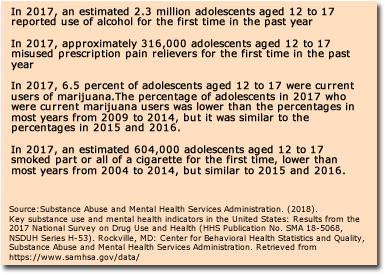Introduction
"A widespread epidemic of illicit drug use emerged in the 1960s among U.S. youth, and since then dramatic changes have occurred in the use of nearly all types of illicit drugs, as well as alcohol and tobacco (Miech 2019)." Today's youth have access to an ever increasing range of licit and illicit drugs. Many new illicit drugs have emerged, along with new forms of alcoholic beverages and tobacco products, synthetic marijuana, synthetic stimulants such as “bath salts,” and drugs taken for strength enhancement.
 Drug usage typically begins around twelve to fourteen years of age and becomes increasingly prevalent up into the twenties. More than half of adolescents have tried an illegal drug, usually cannabis, and about 20% become fairly regular recreational users. It is not easy to avoid interactions with drug users or to recognize that people are on drugs. It is therefore necessary for nurses to know how to handle drug crises, how to discriminate between recreational and life-threatening drug use, and which drug combinations are dangerous.
Drug usage typically begins around twelve to fourteen years of age and becomes increasingly prevalent up into the twenties. More than half of adolescents have tried an illegal drug, usually cannabis, and about 20% become fairly regular recreational users. It is not easy to avoid interactions with drug users or to recognize that people are on drugs. It is therefore necessary for nurses to know how to handle drug crises, how to discriminate between recreational and life-threatening drug use, and which drug combinations are dangerous.
In the case of minors using street drugs, a health crisis often precipitates the eruption of tensions in the parent-teen relationship and the nurse may correctly interpret that resolution of a family upheaval may take precedence over medical issues. The majority of older adults grew up during times when drug users were part of a certain subculture. The subculture was composed of youth susceptible to street drugs because of certain identifiable risk factors such as residency in a low income/high crime rate neighborhood or particular psychosocial vulnerabilities. However, sociologically, a process of moral accommodation has occurred among today’s teenagers. Abstainers seem not to be bothered by drug use within their social circles, as long as freedom to use or not use drugs is respected and others are not harmed. Issues of trust and friendship are pivotal among drug users and dealers, a phenomenon that implies skill in communication, cooperation, negotiation and a certain amount of integrity.
Nurses will use knowledge about street drugs in emergency rooms where teenagers are seen following car accidents, psychotic drug episodes, unexpected complications from drug experimentation and overdoses; in clinics where teenagers are seen for lingering immune problems, chronic respiratory problems, anorexia, fatigue, insomnia and depression; and in the hospital where teenagers may show symptoms of withdrawal from their drugs.
An assumption that unmet basic human needs are at the root of our culture’s drug problem in general may be a philosophical vantage point. In January, 2001, the Surgeon General reported that one in ten children and adolescents suffer from mental illness and that fewer than one in five of these children receive treatment.1 Illegal drug use may be looked at as a form of self-treatment, one that bypasses adult control. The scope of the nurses’ role in addressing, documenting, and delegating responsibility for dealing with drug usage depends on many things. The job description of the nurse as appropriate to the facility and department the nurse works in is the first consideration. For example, an emergency room nurse is not expected to address drug addiction or family relationships, whereas a clinic nurse may be in a position to make timely referrals that alter the course of recurrent drug-related disability. Prioritization of criminal justice and/or protective commitment to institutional care sometimes determines the extent of nursing care possible. A nurse may be only one member of a team of professionals working to determine what is in the best interest of a patient.
Instant
Feedback:
Drug
use generally begins at about age 12 to 14.
Reference:
Miech, R. A., Johnston, L. D., O’Malley, P. M., Bachman, J. G., Schulenberg, J. E., & Patrick, M. E. (2019). Monitoring the Future national survey results on drug use, 1975–2018: Volume I, Secondary school students. Ann Arbor: Institute for Social Research, The University of Michigan.
Substance Abuse and Mental Health Services Administration. (2018). Key substance use and mental health indicators in the United States: Results from the 2017 National Survey on Drug Use and Health (HHS Publication No. SMA 18-5068, NSDUH Series H-53). Rockville, MD: Center for Behavioral Health Statistics and Quality, Substance Abuse and Mental Health Services Administration. Retrieved from https://www. samhsa.gov/data/
 Drug usage typically begins around twelve to fourteen years of age and becomes increasingly prevalent up into the twenties. More than half of adolescents have tried an illegal drug, usually cannabis, and about 20% become fairly regular recreational users. It is not easy to avoid interactions with drug users or to recognize that people are on drugs. It is therefore necessary for nurses to know how to handle drug crises, how to discriminate between recreational and life-threatening drug use, and which drug combinations are dangerous.
Drug usage typically begins around twelve to fourteen years of age and becomes increasingly prevalent up into the twenties. More than half of adolescents have tried an illegal drug, usually cannabis, and about 20% become fairly regular recreational users. It is not easy to avoid interactions with drug users or to recognize that people are on drugs. It is therefore necessary for nurses to know how to handle drug crises, how to discriminate between recreational and life-threatening drug use, and which drug combinations are dangerous.